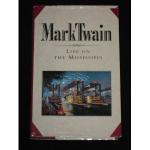In the beginning Quincy had the aspect and ways of a model New England town: and these she has yet: broad, clean streets, trim, neat dwellings and lawns, fine mansions, stately blocks of commercial buildings. And there are ample fair-grounds, a well kept park, and many attractive drives; library, reading-rooms, a couple of colleges, some handsome and costly churches, and a grand court-house, with grounds which occupy a square. The population of the city is thirty thousand. There are some large factories here, and manufacturing, of many sorts, is done on a great scale.
La Grange and Canton are growing towns, but I missed Alexandria; was told it was under water, but would come up to blow in the summer.
Keokuk was easily recognizable. I lived there in 1857—an extraordinary year there in real-estate matters. The ‘boom’ was something wonderful. Everybody bought, everybody sold—except widows and preachers; they always hold on; and when the tide ebbs, they get left. Anything in the semblance of a town lot, no matter how situated, was salable, and at a figure which would still have been high if the ground had been sodded with greenbacks.
The town has a population of fifteen thousand now, and is progressing with a healthy growth. It was night, and we could not see details, for which we were sorry, for Keokuk has the reputation of being a beautiful city. It was a pleasant one to live in long ago, and doubtless has advanced, not retrograded, in that respect.
A mighty work which was in progress there in my day is finished now. This is the canal over the Rapids. It is eight miles long, three hundred feet wide, and is in no place less than six feet deep. Its masonry is of the majestic kind which the War Department usually deals in, and will endure like a Roman aqueduct. The work cost four or five millions.
After an hour or two spent with former friends, we started up the river again. Keokuk, a long time ago, was an occasional loafing-place of that erratic genius, Henry Clay Dean. I believe I never saw him but once; but he was much talked of when I lived there. This is what was said of him—
He began life poor and without education. But he educated himself—on the curbstones of Keokuk. He would sit down on a curbstone with his book, careless or unconscious of the clatter of commerce and the tramp of the passing crowds, and bury himself in his studies by the hour, never changing his position except to draw in his knees now and then to let a dray pass unobstructed; and when his book was finished, its contents, however abstruse, had been burnt into his memory, and were his permanent possession. In this way he acquired a vast hoard of all sorts of learning, and had it pigeon-holed in his head where he could put his intellectual hand on it whenever it was wanted.
His clothes differed in no respect from a ‘wharf-rat’s,’ except that they were raggeder, more ill-assorted and inharmonious (and therefore more extravagantly picturesque), and several layers dirtier. Nobody could infer the master-mind in the top of that edifice from the edifice itself.




